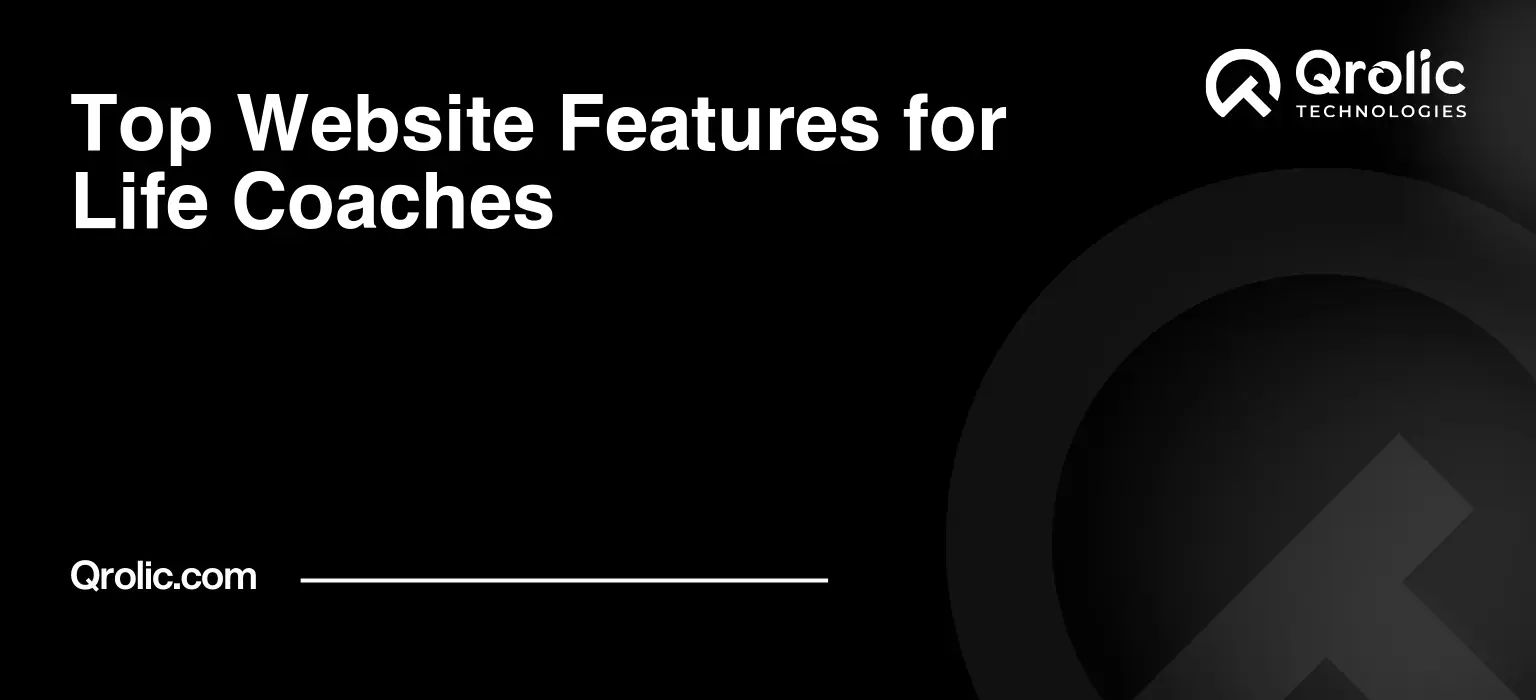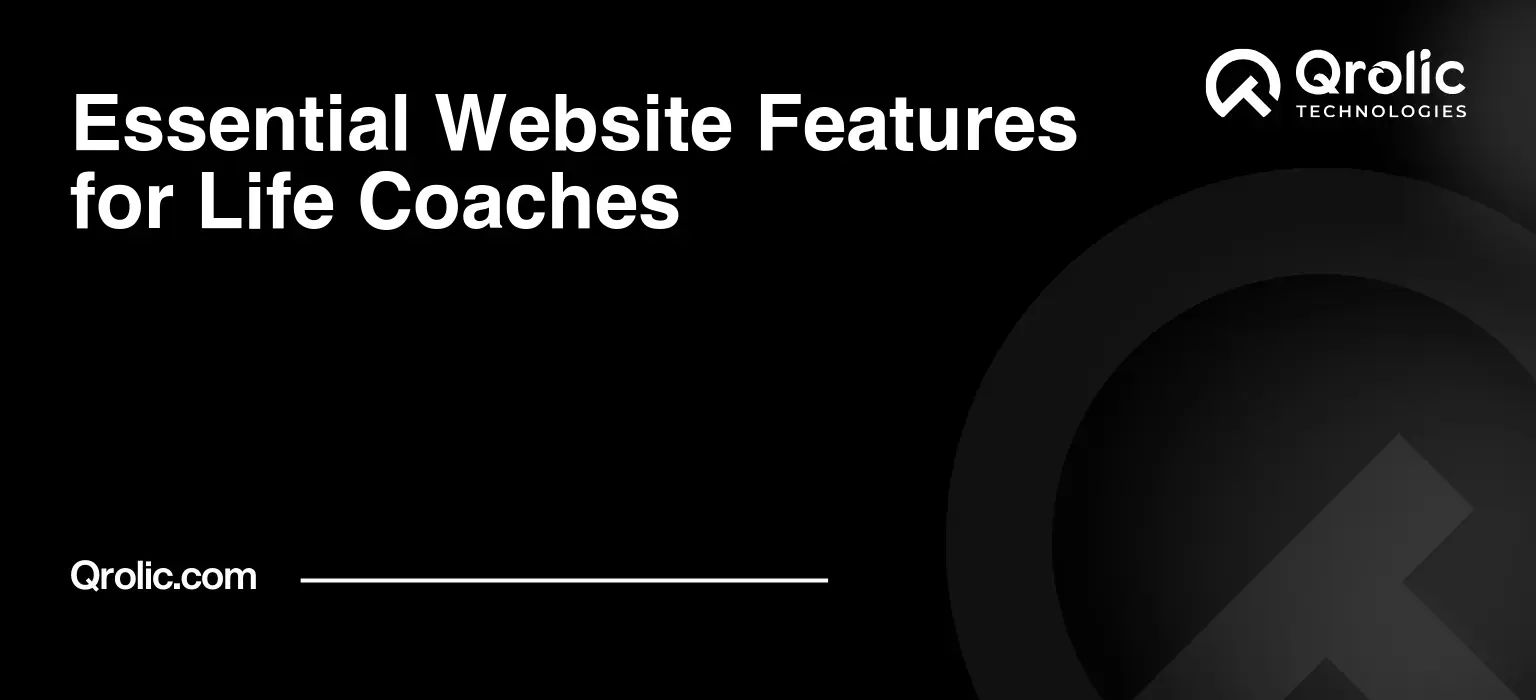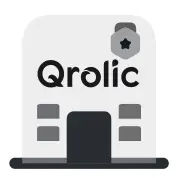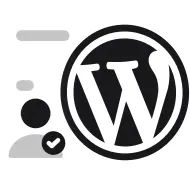Quick Summary:
- Ensure your website has clear info and easy navigation.
- Add blogs and free resources to attract new clients.
- Optimize your site for search engines to be found easily.
- Track website performance to see what works best.
Table of Contents
- Top Website Features for Life Coaches
- Creating a Compelling Online Presence: Why Your Website Matters
- Core Website Foundation: The Essentials
- 1. Crystal-Clear Value Proposition: What Do You Offer?
- 2. User-Friendly Navigation: Guiding Your Visitors
- 3. Compelling “About” Page: Building Trust and Connection
- 4. Detailed Services Page: Showcasing Your Offerings
- 5. Professional Contact Page: Making It Easy to Connect
- Enhancing Engagement and Lead Generation: The Power of Interactive Features
- 6. Blog: Sharing Your Expertise and Building Authority
- 7. Free Resources: Attracting Leads with Value
- 8. Email Marketing Integration: Nurturing Leads and Building Relationships
- 9. Online Scheduling: Streamlining the Booking Process
- 10. Testimonials and Social Proof: Building Trust and Credibility
- 11. Client Portal: Enhancing Client Experience
- Optimizing for Search Engines: Making Your Website Findable
- 12. Keyword Research: Understanding Your Audience’s Search Terms
- 13. On-Page Optimization: Optimizing Your Website Content
- 14. Off-Page Optimization: Building Authority and Backlinks
- 15. Mobile Optimization: Catering to Mobile Users
- 16. Website Speed Optimization: Ensuring a Smooth User Experience
- ADA Compliance: Ensuring Accessibility for All
- Key Performance Indicators (KPIs): Measuring Your Website’s Success
- 17. Website Traffic: Monitoring Your Website’s Reach
- 18. Bounce Rate: Understanding User Engagement
- 19. Conversion Rate: Measuring Lead Generation and Sales
- 20. Time on Site: Gauging User Interest
- 21. Page Load Speed: Ensuring a Fast User Experience
- The Role of a Professional Website Developer
- Qrolic Technologies: Your Partner in Building a Successful Online Presence
- Final Thoughts: Your Website – An Investment in Your Success
Top Website Features for Life Coaches
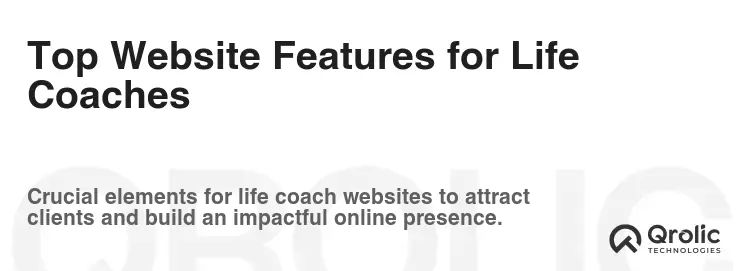
Creating a Compelling Online Presence: Why Your Website Matters
In today’s digital age, your website is often the first impression you make on potential clients. For life coaches, this is especially crucial. Your website isn’t just a digital brochure; it’s a virtual representation of your coaching philosophy, your expertise, and your ability to guide and support individuals towards their goals. A well-designed website acts as a powerful tool for attracting the right clients, establishing credibility, and ultimately, growing your coaching business. Ignoring the power of a dedicated and optimized website is akin to leaving potential clients on the table. They might be searching for exactly what you offer, but without a strong online presence, they’ll never find you. This article delves into the essential features that will transform your life coach website from a simple online listing to a powerful lead generation and client engagement hub.
Core Website Foundation: The Essentials
Before diving into advanced features, let’s establish the fundamental building blocks of an effective life coach website. These elements are non-negotiable and form the base upon which you’ll build a thriving online presence.
1. Crystal-Clear Value Proposition: What Do You Offer?
- Why It Matters: Visitors should understand what you do and how you can help them within seconds of landing on your homepage. Clarity eliminates confusion and encourages them to explore further.
- How to Implement:
- Headline: Use a compelling headline that highlights the core benefit you provide. (e.g., “Unlock Your Potential: Life Coaching to Achieve Your Dreams”)
- Subheadline: Elaborate on your headline with a concise explanation of your services. (e.g., “Transform Your Career, Relationships, and Confidence with Personalized Coaching.”)
- Visuals: Use high-quality images and videos that visually represent the positive outcomes of your coaching. (e.g., a photo of someone confidently presenting, a couple laughing, or a person meditating peacefully.)
- Benefit-Driven Language: Focus on the benefits clients receive, not just the features of your coaching. (e.g., “Gain clarity and direction” instead of “Weekly coaching sessions.”)
- Example: “Feeling Stuck? I Help You Break Through Barriers and Achieve Your Full Potential.”
- Benefits: Increased self-awareness, improved decision-making, enhanced confidence.
2. User-Friendly Navigation: Guiding Your Visitors
- Why It Matters: A well-structured website ensures visitors can easily find the information they need. Intuitive navigation leads to higher engagement and lower bounce rates.
- How to Implement:
- Simple Menu: Use a clear and concise main menu with easily understandable labels (e.g., “About,” “Services,” “Testimonials,” “Blog,” “Contact”).
- Logical Structure: Organize your content logically, grouping related topics together.
- Search Functionality: Include a prominent search bar for visitors who know exactly what they’re looking for.
- Mobile-Friendly Design: Ensure your website is fully responsive and provides a seamless experience on all devices (desktops, tablets, smartphones).
- Breadcrumbs: Implement breadcrumbs to help users understand their location within the site and easily navigate back to previous pages.
3. Compelling “About” Page: Building Trust and Connection
- Why It Matters: Your “About” page is where you connect with potential clients on a personal level. It’s your opportunity to share your story, your passion, and your qualifications.
- How to Implement:
- Your Story: Share your personal journey and what led you to become a life coach. Authenticity resonates with people.
- Your Philosophy: Explain your coaching philosophy and approach. What makes your coaching unique?
- Your Qualifications: Highlight your certifications, training, and experience. This establishes your credibility.
- Personal Touch: Use a friendly and approachable tone. Include a professional photo of yourself.
- Client Focus: Frame your story and qualifications in terms of how they benefit your clients.
- Example: “As a former [your past profession], I understand the challenges of [common challenge faced by your target audience]. That’s why I’m passionate about helping others overcome obstacles and achieve their dreams.”
4. Detailed Services Page: Showcasing Your Offerings
- Why It Matters: Clearly outline the services you offer, including the benefits, process, and pricing (if applicable). This helps potential clients understand the value you provide.
- How to Implement:
- Service Descriptions: Provide detailed descriptions of each service, highlighting the specific outcomes clients can expect.
- Target Audience: Specify who each service is designed for.
- Packages and Pricing: If you offer different packages, clearly outline the inclusions and pricing for each. Be transparent about your fees.
- Call to Action: Include a clear call to action for each service, such as “Book a Consultation” or “Learn More.”
- Social Proof: Integrate testimonials or case studies related to specific services to build trust.
5. Professional Contact Page: Making It Easy to Connect
- Why It Matters: Make it easy for potential clients to contact you. A clear and accessible contact page shows you’re approachable and responsive.
- How to Implement:
- Contact Form: Include a contact form for inquiries. Keep it simple and only ask for essential information.
- Email Address: Provide a professional email address.
- Phone Number: If you’re comfortable, include your phone number.
- Social Media Links: Link to your social media profiles.
- Map (if applicable): If you have a physical office, embed a map to help people find you.
- Call to Action: Encourage visitors to reach out with a clear call to action (e.g., “Get in Touch,” “Schedule a Call”).
Enhancing Engagement and Lead Generation: The Power of Interactive Features
Once you have the foundational elements in place, it’s time to add interactive features that engage visitors, capture leads, and nurture relationships. These features transform your website from a passive brochure into an active lead generation machine.
6. Blog: Sharing Your Expertise and Building Authority
- Why It Matters: A blog allows you to share your knowledge, insights, and tips with your target audience. It establishes you as an expert in your field, attracts organic traffic from search engines, and provides valuable content to share on social media.
- How to Implement:
- Target Audience: Write blog posts that address the specific challenges and interests of your ideal clients.
- Valuable Content: Provide actionable advice, practical tips, and inspiring stories.
- Consistent Posting: Maintain a regular posting schedule to keep your audience engaged and attract search engines.
- SEO Optimization: Optimize your blog posts for relevant keywords to improve search engine rankings.
- Call to Action: Include a call to action at the end of each blog post, encouraging readers to sign up for your email list or book a consultation.
- Content Ideas:
- “5 Strategies to Overcome Procrastination”
- “How to Build Confidence in Your Career”
- “The Importance of Mindfulness in Relationships”
- “Setting Realistic Goals and Achieving Them”
- “Building Resilience in the Face of Adversity”
7. Free Resources: Attracting Leads with Value
- Why It Matters: Offering valuable free resources, such as ebooks, checklists, guides, or templates, is a powerful way to attract leads and build your email list. People are more likely to provide their contact information if they receive something of value in return.
- How to Implement:
- Relevant Content: Create resources that are highly relevant to your target audience and their needs.
- High Quality: Ensure your resources are well-written, visually appealing, and provide practical value.
- Opt-in Forms: Use opt-in forms to collect email addresses in exchange for the free resource.
- Landing Pages: Create dedicated landing pages for each free resource to maximize conversions.
- Promotion: Promote your free resources on your website, social media, and email marketing.
- Resource Ideas:
- “Goal Setting Workbook”
- “Confidence-Boosting Checklist”
- “Stress Management Guide”
- “Relationship Communication Template”
- “Career Planning Roadmap”
8. Email Marketing Integration: Nurturing Leads and Building Relationships
- Why It Matters: Email marketing is a highly effective way to nurture leads, build relationships, and promote your services. By collecting email addresses, you can stay in touch with potential clients, provide valuable content, and offer exclusive promotions.
- How to Implement:
- Email Marketing Platform: Choose a reliable email marketing platform (e.g., Mailchimp, ConvertKit, ActiveCampaign).
- Opt-in Forms: Integrate opt-in forms on your website to collect email addresses.
- Segmentation: Segment your email list based on interests, demographics, or behavior.
- Automated Sequences: Create automated email sequences to nurture leads and guide them through the sales process.
- Valuable Content: Provide valuable content in your emails, such as blog posts, tips, and exclusive offers.
- Personalization: Personalize your emails to make them more engaging and relevant.
9. Online Scheduling: Streamlining the Booking Process
- Why It Matters: Online scheduling makes it easy for potential clients to book consultations or coaching sessions directly through your website. This streamlines the booking process, saves time, and reduces friction.
- How to Implement:
- Scheduling Tool: Choose a reliable online scheduling tool (e.g., Acuity Scheduling, Calendly, Book Like a Boss).
- Integration: Integrate the scheduling tool seamlessly into your website.
- Availability: Set your availability and prevent double-bookings.
- Customization: Customize the scheduling tool to match your brand and preferences.
- Automated Reminders: Set up automated reminders to reduce no-shows.
10. Testimonials and Social Proof: Building Trust and Credibility
- Why It Matters: Testimonials and social proof are essential for building trust and credibility. Potential clients are more likely to work with you if they see that others have had positive experiences.
- How to Implement:
- Collect Testimonials: Ask satisfied clients for testimonials.
- Display Prominently: Display testimonials prominently on your website, especially on your homepage and services pages.
- Video Testimonials: Consider using video testimonials for a more engaging and impactful effect.
- Case Studies: Share case studies that highlight the results you’ve achieved for clients.
- Social Media Integration: Display social media feeds or reviews on your website.
11. Client Portal: Enhancing Client Experience
- Why It Matters: A client portal allows clients to access resources, track progress, and communicate with you in a secure and convenient online environment. This enhances the client experience and strengthens your relationships.
- How to Implement:
- Secure Access: Provide secure login credentials for each client.
- Resource Library: Create a resource library with helpful documents, videos, and templates.
- Progress Tracking: Allow clients to track their progress towards their goals.
- Communication Tools: Integrate communication tools, such as messaging or video conferencing.
- Payment Integration: Integrate payment processing for easy billing and payment.
Optimizing for Search Engines: Making Your Website Findable
Creating a beautiful and engaging website is only half the battle. You also need to optimize it for search engines so that potential clients can find you online.
12. Keyword Research: Understanding Your Audience’s Search Terms
- Why It Matters: Keyword research helps you understand the terms that your target audience is using to search for life coaches online. By targeting these keywords, you can improve your search engine rankings and attract more organic traffic.
- How to Implement:
- Brainstorming: Brainstorm a list of keywords related to your services and target audience.
- Keyword Tools: Use keyword research tools (e.g., Google Keyword Planner, SEMrush, Ahrefs) to identify high-volume, low-competition keywords.
- Long-Tail Keywords: Focus on long-tail keywords (longer, more specific phrases) to attract highly qualified leads.
- Competitor Analysis: Analyze your competitors’ websites to identify their target keywords.
13. On-Page Optimization: Optimizing Your Website Content
- Why It Matters: On-page optimization involves optimizing your website content to improve its relevance and ranking in search results.
- How to Implement:
- Title Tags: Optimize your title tags with relevant keywords.
- Meta Descriptions: Write compelling meta descriptions that entice users to click on your website in search results.
- Header Tags: Use header tags (H1, H2, H3) to structure your content and highlight important keywords.
- Content Optimization: Incorporate relevant keywords naturally throughout your website content.
- Image Optimization: Optimize your images with descriptive alt tags.
- Internal Linking: Link to other relevant pages on your website to improve navigation and search engine ranking.
14. Off-Page Optimization: Building Authority and Backlinks
- Why It Matters: Off-page optimization involves building authority and backlinks to your website from other reputable websites. This signals to search engines that your website is trustworthy and valuable.
- How to Implement:
- Guest Blogging: Write guest blog posts for other websites in your industry.
- Link Building: Earn backlinks from other relevant websites.
- Social Media Marketing: Promote your website and content on social media.
- Directory Submissions: Submit your website to relevant online directories.
- Online Reputation Management: Monitor your online reputation and address any negative reviews.
15. Mobile Optimization: Catering to Mobile Users
- Why It Matters: A significant portion of internet users access the web on mobile devices. Ensuring your website is mobile-friendly is crucial for providing a positive user experience and improving your search engine ranking.
- How to Implement:
- Responsive Design: Use a responsive design that adapts to different screen sizes.
- Mobile-Friendly Navigation: Ensure your navigation is easy to use on mobile devices.
- Fast Loading Speed: Optimize your website for fast loading speed on mobile devices.
- Touch-Friendly Design: Design your website with touch-friendly elements, such as large buttons and easy-to-tap links.
16. Website Speed Optimization: Ensuring a Smooth User Experience
- Why It Matters: Website speed is a critical factor for user experience and search engine ranking. Slow-loading websites can frustrate visitors and lead to higher bounce rates.
- How to Implement:
- Image Optimization: Optimize your images for web use to reduce file sizes.
- Caching: Implement caching to store frequently accessed data and reduce server load.
- Content Delivery Network (CDN): Use a CDN to distribute your website content across multiple servers for faster delivery.
- Code Minification: Minify your HTML, CSS, and JavaScript code to reduce file sizes.
- Choose a Fast Hosting Provider: Select a reliable hosting provider with fast servers.
ADA Compliance: Ensuring Accessibility for All
- Why It Matters: Ensuring your website is ADA (Americans with Disabilities Act) compliant is not only ethically responsible but also legally required in many cases. It ensures that individuals with disabilities can access and use your website effectively.
- How to Implement:
- Alt Text for Images: Provide descriptive alt text for all images.
- Keyboard Navigation: Ensure your website can be navigated using only a keyboard.
- Color Contrast: Use sufficient color contrast between text and background.
- Clear and Concise Language: Use clear and concise language that is easy to understand.
- Captioning for Videos: Provide captions for all videos.
- Use of ARIA Attributes: Use ARIA (Accessible Rich Internet Applications) attributes to enhance accessibility for assistive technologies.
- Regular Audits: Conduct regular accessibility audits to identify and fix any issues.
Key Performance Indicators (KPIs): Measuring Your Website’s Success
To ensure your website is achieving its goals, it’s crucial to track key performance indicators (KPIs). These metrics provide valuable insights into your website’s performance and help you identify areas for improvement.
17. Website Traffic: Monitoring Your Website’s Reach
- How to Measure: Use tools like Google Analytics to track website traffic, including the number of visitors, page views, and sessions.
- What to Track:
- Overall Traffic: The total number of visitors to your website.
- Traffic Sources: Where your website traffic is coming from (e.g., organic search, social media, referrals).
- Mobile Traffic: The percentage of visitors accessing your website on mobile devices.
18. Bounce Rate: Understanding User Engagement
- How to Measure: Track the bounce rate, which is the percentage of visitors who leave your website after viewing only one page.
- What to Look For: A high bounce rate may indicate that your website is not engaging or relevant to visitors.
19. Conversion Rate: Measuring Lead Generation and Sales
- How to Measure: Track the conversion rate, which is the percentage of visitors who take a desired action, such as signing up for your email list, booking a consultation, or purchasing a service.
- What to Look For: A low conversion rate may indicate that your website is not effectively converting visitors into leads or customers.
20. Time on Site: Gauging User Interest
- How to Measure: Track the average time visitors spend on your website.
- What to Look For: A longer time on site suggests that visitors are engaged with your content.
21. Page Load Speed: Ensuring a Fast User Experience
- How to Measure: Use tools like Google PageSpeed Insights to measure your website’s page load speed.
- What to Look For: Faster page load speeds are essential for user experience and search engine ranking.
The Role of a Professional Website Developer
While many DIY website builders are available, partnering with a professional website developer can significantly enhance the quality, functionality, and overall effectiveness of your life coach website. A developer brings expertise in design, coding, SEO, and user experience to create a website that truly reflects your brand and achieves your business goals.
Qrolic Technologies: Your Partner in Building a Successful Online Presence
At Qrolic Technologies, we understand the unique needs of life coaches and are dedicated to helping you build a website that attracts clients, establishes your expertise, and grows your business. We offer a comprehensive range of website development services, including:
- Custom Website Design: We create visually appealing and user-friendly websites that reflect your brand and resonate with your target audience.
- SEO Optimization: We optimize your website for search engines to improve your ranking and attract more organic traffic.
- Lead Capture Integration: We integrate lead capture forms and email marketing tools to help you build your email list and nurture leads.
- Online Scheduling Implementation: We integrate online scheduling tools to streamline the booking process and make it easy for clients to book consultations.
- Content Management System (CMS): We build your website on a user-friendly CMS, such as wordpress, so you can easily manage and update your content.
- Ongoing Support and Maintenance: We provide ongoing support and maintenance to ensure your website remains secure and up-to-date.
We understand that investing in a professional website is an investment in your business’s future. Let Qrolic Technologies help you create a website that empowers you to reach more clients and achieve your coaching goals. Contact us today to discuss your project.
Final Thoughts: Your Website – An Investment in Your Success
Your website is more than just an online presence; it’s a powerful tool for building your brand, attracting clients, and growing your life coaching business. By implementing the features discussed in this article, you can create a website that not only looks professional but also effectively engages visitors, captures leads, and converts them into loyal clients. Remember to continuously analyze your website’s performance, adapt to changing trends, and invest in ongoing maintenance and improvements to ensure it remains a valuable asset for your business. Your website is an investment in your success, and with the right features and optimization, it can help you achieve your goals and make a positive impact on the lives of your clients. Embrace the digital landscape and create a website that truly represents your unique value proposition and empowers you to thrive in the competitive world of life coaching.
